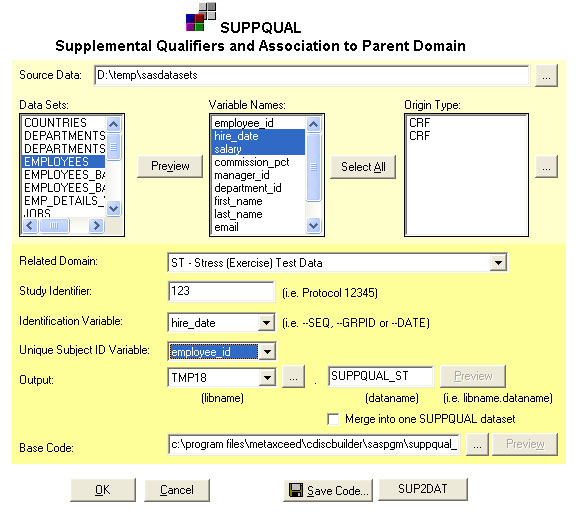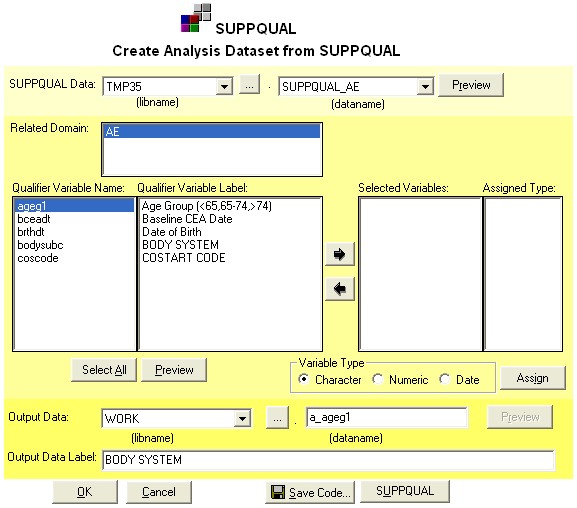|
Overview
The Supplemental Qualifiers (SUPPQUAL) dataset is used to capture
non-standard variables and their association to parent records in domains.
It also allows capturing values for variables not presently included in
the general observation class models. Because the CDISC SDTM does not
allow the addition of new variables, it is necessary to represent the
metadata and data for each non-standard variable/value combination in the
SUPPQUAL dataset.
The creation and updates to the
SUPPQUAL dataset requires data transformation that can be time consuming.
The SUPPQUAL utility automates this process by generating the dataset upon
specific input dataset requested. It also can be used to synchronize
and update the existing SUPPQUAL dataset as the source data is being
updated.
SUPPQUAL
Options
The SUPPQUAL screen allows you to select the source data, variables and related
options which is used in creating the SUPPQUAL data. The data flow for this tool is shown here.
|
Source Data |
 |
CDISC Builder
SUPPQUAL |
 |
SUPPQUAL
Dataset |
|

The options available for
selecting data and options for SUPPQUAL are:
- Source Data - This is the
location of the dataset that is going to be used to generating the
SUPPQUAL data.
- Datasets - Source datasets that
are used to for SUPPQUAL.
- Preview - A preview of the
first 100 observations of the data that is selected.
- Variable Origin - Variables can
have different origins. Default origin values include CRF,
Assigned or Derived. This can be assigned for each variable.
- Related Domain - The related
domain to CDISC that the dataset is related to.
- Study Identifier - The study
name or protocol number for the supplemental qualifier.
- Identification Variable - A
variable that can be used to sort the data so that it uniquely
identifies each observation of the supplemental qualifier.
- Unique Subject ID Variable -
The variable in the source data that corresponds to the Unique Subject
ID.
- Output - The libname and
dataset name that is being updated or created for the supplemental
qualifier.
This is usually named SUPPQUAL.
- Base Code - Path and file name
containing the SAS program used to generate the supplemental qualifier.
- Save Code - The location of the
program that contains the macro call with all the selected parameters
used to create the supplemental qualifier.
 |
The SUPPQUAL can be used to
generate transport files from multiple sources. |
SUP2DAT
Converting SUPPQUAL to Datasets
In addition to transforming SAS datasets to SUPPQUAL, CDISC Builder
also has an option to converting SUPPQUAL data back into SAS
datasets. This option is available through the button entitled
"SUP2DAT" on the main SUPPQUAL screen. When this is
selected, the following screen is presented.

The options that are available are
described here:
- SUPPQUAL Data - This includes
both the library name and the name of the dataset that contains the
SUPPQUAL data.
- Preview - A preview of the
first 100 observations of the SUPPQUAL data that is selected.
- Related Domain - The related
domain to CDISC that the dataset is related to.
- Qualifier Variable and Label -
Variables that has been found in the SUPPQUAL that contain the
original qualifying values from the analysis dataset. The
selection of these will then be converted back into the analysis
variables.
- Variable Type - The conversion
of the SUPPQUAL back into analysis variables will applied according to
the specified variable type. The conversion will include types:
character, numeric or date.
- Output - The libname and
dataset name for the analysis file that is being created from the
SUPPQUAL data. This will be defaulted to have the prefix of
"a_" followed by the first variable selected.
- Output Data Label - The label
of the SAS dataset that will be created for the analysis file.
- Save Code - The location of the
program that contains the macro call with all the selected parameters
used to create the analysis dataset.
 |
The analysis data will be created
successfully if the input SUPPQUAL data was created from CDISC
Builder. |
|